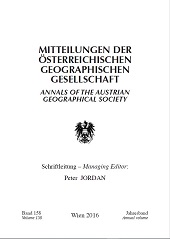
Mitteilungen der Österreichischen Geographischen Gesellschaft Band 158/2016, pp. 215-244, 2019/05/27
158. Jg. (Jahresband), Wien 2016

Collective identity is a significant factor for economic, social and territorial cohesion, but in the absence of coordinated local and regional initiatives, traditional communities are running the risk of losing their values in the near future. The aim of our paper was (1) to explore the main identity features of the Land of Năsăud, Romania, tracing them back to a significant period for its social and economic development as a region: The Military Frontier District of Năsăud (1762–1851), part of the Austrian Military Frontier, and (2) to give empirical arguments that identity enables development. The success of implementing the institutionalised Military Frontier system in the mid-18th century (initiated by Maria Theresa and continued by Joseph II) was due to the civic spirit of the Habsburg Empire and to the characteristic situations of each territory, which was militarised. We employed a qualitative analysis of the data from a survey targeting the identity features of the region of Năsăud as perceived by its inhabitants and analysed the present activities based on territorial identity. We concluded with a series of development measures and that regional identity is a resource that supports development initiatives in the Land of Năsăud and implicitly in other ‘landʼ type regions, in former Military Frontier districts, and in conservative regional communities.
Keywords: Năsăud, Austrian Military Frontier, space-related identity, regional development, Romania